#slave rebellion
Explore tagged Tumblr posts
Text



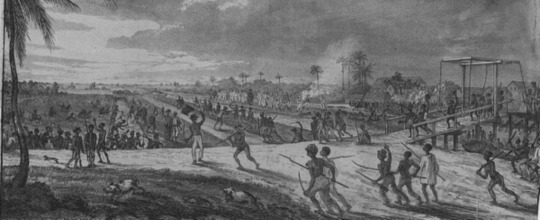
List of notable slave revolts in the Caribbean during the Transatlantic/European Slave Trade. These Slave revolts emphasise the collective struggle for liberation,
unity, and self-determination:
1. The 1638 St. Kitts Slave Revolt: Enslaved Africans resisted early attempts by European colonizers to dominate the island. This uprising showed that from the very beginning, Africans refused to accept their dehumanization and fought to retain their dignity.
2. Barbados Revolt of 1649: Africans in Barbados challenged the plantation system, laying the foundation for future resistance. This revolt demonstrated the shared struggle of African people across different colonies.
3. The 1675 Curaçao Revolt: Enslaved Africans, many of whom were from the Akan and other warrior societies in West Africa, plotted to overthrow the Dutch colonists. This revolt highlighted the persistence of African resistance traditions, even in exile.
4. Tacky’s War (1760, Jamaica) :Led by Akan warriors like Tacky, this revolt was deeply rooted in African military traditions. It was a call for liberation and unity, showcasing the resilience of African cultures under enslavement.
5. Berbice Slave Rebellion (1763, Guyana): Under Cuffy (Kofi), enslaved Africans controlled parts of Berbice for over a year. This Pan-African hero envisioned an independent African-led society in the Americas, directly challenging European colonialism.
6. Coromantee Wars (1765–1766, Jamaica): Enslaved Akan Africans led revolts against British plantation owners. The unity of African warriors in organizing these rebellions demonstrated the spirit of Pan-Africanism.
7. 1773 Grenada Revolt: Africans resisted their French and British oppressors, reflecting a Pan-African vision of collective liberation and defiance against European exploitation.
8. The First Maroon War (1728–1740, Jamaica): Maroons, descendants of escaped Africans, fought the British for autonomy. Their victory in establishing independent territories was a significant Pan-African triumph.
9. Haitian Revolution (1791–1804, Saint-Domingue): The most powerful expression of Pan-Africanism in the Caribbean, this revolution united enslaved Africans and free people of color. Leaders like Toussaint Louverture, Jean-Jacques Dessalines, and others overthrew French rule, ending slavery and creating the first Black republic.
10. Bussa’s Rebellion (1816, Barbados): Bussa, inspired by the African tradition of communal resistance, led this uprising against British slavery. It echoed Garveyite ideals of self-determination before their time.
11. Demerara Rebellion (1823, Guyana): Led by Jack Gladstone and Quamina, this revolt sought freedom for Africans in British Guiana. It reflected a broader Pan-African consciousness and the demand for dignity and justice.
12. Baptist War (1831–1832, Jamaica): Also known as the Christmas Rebellion, it was led by Samuel Sharpe, who united enslaved people under the banner of Christian and African liberation. This revolt hastened the abolition of slavery in the British Empire.
13. The Second Maroon War (1795–1796, Jamaica): Maroons resisted British incursions into their autonomy, preserving their African-rooted systems of governance and solidarity.
14. 1837 St. Lucia Revolt: Enslaved Africans rose up against British oppression. Their resistance embodied Pan-African ideals, rejecting the colonial domination of their homeland.
15. Trinidad Slave Revolt (1838): Enslaved Africans on the brink of emancipation staged a revolt, demonstrating their refusal to accept anything less than complete freedom.
16. 1733 St. John Slave Revolt (Virgin Islands): Enslaved Africans, many of whom were Akan, took control of the Danish colony for several months. Their strategic unity reflected a Pan-African ethos.
17. Leeward Maroon Wars (1730s–1740s, Antigua and Jamaica): These wars involved guerrilla tactics by escaped Africans who maintained cultural and spiritual links to their homelands.
18. Martinique Revolt (1833): Enslaved Africans rose up against French rule, signalling the unity of Black people against colonial oppressors across linguistic and cultural divides.
19. Santo Domingo Resistance (1795, Dominican Republic): Inspired by the Haitian Revolution, enslaved Africans rebelled, resisting both Spanish and French colonial systems.
#black people#black#black history#black tumblr#blacktumblr#pan africanism#black conscious#africa#black power#black empowering#slave revolts#Slave Rebellion#trans atlantic slave trade#african history#black culture#african culture#black community#caribbean history#afro caribbean culture#black liberation#black freedom#uprising#black revolution
248 notes
·
View notes
Text

The Death of Spartacus by Hermann Vogel
#spartacus#art#hermann vogel#ancient rome#slave revolt#slave rebellion#history#antiquity#thracian#gladiator#gladiators#roman republic#roman#romans#rebellion#revolt#uprising#europe#european#servile wars#third servile war#italy
182 notes
·
View notes
Text
September 9th marks the 284th anniversary of The Stono Rebellion of 1739✊🏾

When an Angolan brotha called, Jemmy, led a band of 20 slaves into rebellion on the banks of the Stono River in Charleston, S.C., which put unprecedented fear in Whites. It was because of this uprising that laws were enacted that outlawd the enslaved from learning how to read, gathering in groups, & growing their own food. Thus, making it one of the most significant rebellions in the history of the U.S. colonies.
Jemmy & the rebel band marched southbound on a road toward the river, carrying banners that proclaimed their war very, "Liberty!". Their numbers swelled with more enslaved women and men as they went. By nightfall, 100 rebels had joined the cause. They broke into a local firearms store, arming themselves with guns & ammo. As they marched, they killed every overseer in their path and forced any reluctant slaves to join them.
From there the band marched toward the house of a Mr. Godfrey, where they burned the house & killed Godfrey and his family. It was just shy of dawn when they reached Wallace's Tavern. Because the innkeeper at the tavern was kind to his slaves, his life was spared. The White inhabitants of the next several houses in their path were all slaughtered. Those enslaved by a Thomas Rose reluctantly joined the rebellion, but not before hiding their slaver - of which they were later rewarded for. Still, many more rebels gladly joined the cause. By this point, a Lieutenant Governor Bull eluded the rebels & rode on horseback to spread the alarm. Once the band reached the Edisto River, Whites colonists set out in armed pursuit. Shots were exchanged across both lines. By dusk, about 30 rebels had fallen & at least 30 more had escaped. In the end, most rebels were captured over the next month, then executed. The remainder were pursued and captured over the following 6mo - all except 1 who remained a fugitive for 3 years. The few survivors were sold off to plantations in the West Indies.

The immediate factors that sparked the uprising remain uncertain. Many rebels knew of small groups of runaways had made their way from SC to FL, where they had been given freedom and land. There was also an ongoing malaria epidemic surging across SC. Ultimately, this unprecedented act of rebellion demanded unprecedented legislature. The European colonists finalized a Negro Act into law which aggressively limited the privileges & movement of the enslaved. No longer would slaves be allowed to grow their own food, assemble in groups, earn their own money, or learn to read. Some of these restrictions had been in effect before the Negro Act of 1740, but had not been strictly enforced. This also resulted in the forced indoctrination of slaves into Christian schools systems.
Let us remember Brother Jemmy and those who fought, willingly or not, against the colonizers. Their sacrifice may have set a great legal precedent in European colonizer politics, but it set an even greater one that would spark many fires and fan many more flames of rebellion, war, and freedom. Every step taken from this moment onward was a necessary one to achieve our "freedom" as we experience it today.
We pour libations of water (especiallyfrom the Stono River), speak their names, & offer prayers toward their elevation.
‼️Note: offering suggestions are just that & strictly for veneration purposes only. Never attempt to conjure up any spirit or entity without proper divination/Mediumship counsel.‼️
#hoodoo#hoodoos#atr#the hoodoo calendar#atrs#the Stono Rebellion#stono river#Angola#Angolan#slave rebellion#south carolina
380 notes
·
View notes
Text

Nat Turner: A Rebel's Quest for Freedom and Inspiring Resistance
#nat turner#black power#south hampton vrginia#the birth of a nation#black excellence#slave rebellion#tik tok#black tik tok
148 notes
·
View notes
Text

‘Toussaint L'Ouverture (1870)’ — George DeBaptiste (American, 1815-1875), chromolithograph ; 74.5 x 58.6 cm, Library of Congress, Washington, D.C.
#toussaint louverture#moors#moorish#haiti#haitian revolution#maroons#jacobins#slave rebellion#george debaptiste#chromolithography#american art#19th century#fez hat#library of congress
23 notes
·
View notes
Text

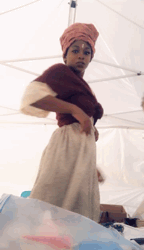



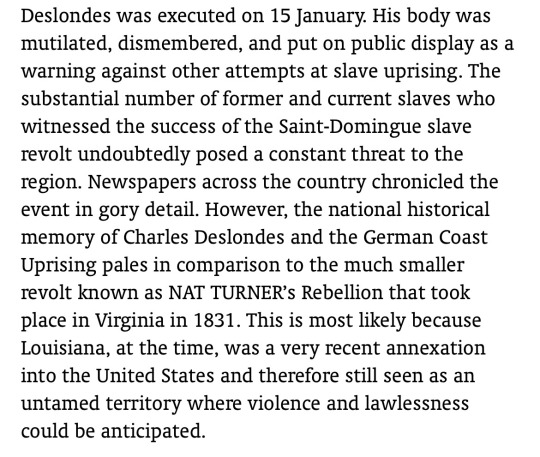

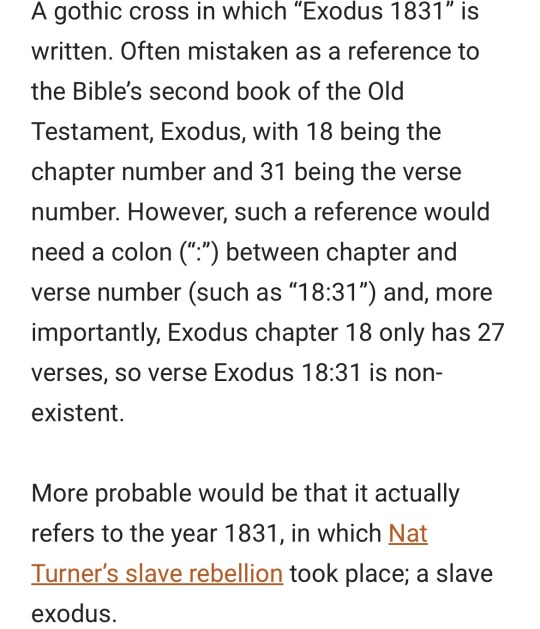
#this week#2019#German coast#uprising#slave rebellion#reenactment#thanks#Nola news#I found that stick#&made the fake baby#most people#had real props#lol
27 notes
·
View notes
Text
The 1791 Haitian Revolution of Black Slaves
Check out the newest LOST IN HISTORY blog post!
Haitian Black Slaves revolt against French control in 1791 The Haitian Revolution was the largest, most successful slave rebellion in the Western World. Black slaves initiated a rebellion in 1791 and by 1803, they’d ended not just slavery, but achieved independence over French colonial rule. Ironically, it was influenced by the French Revolution of 1789. This had brought forth new concepts of…
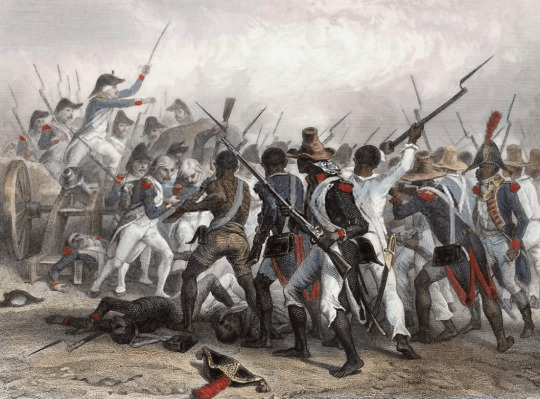
View On WordPress
3 notes
·
View notes
Text

5 notes
·
View notes
Text

Paul Bogle (1822–1865) was a Jamaican Baptist deacon, farmer, and activist, widely regarded as a national hero of Jamaica. He played a key role in the Morant Bay Rebellion of 1865, an uprising against social and economic injustices faced by the African-Jamaican population during British colonial rule.
Bogle lived in Stony Gut, St. Thomas Parish, and was deeply influenced by his Christian faith and the teachings of George William Gordon, a politician and fellow activist. Known for his leadership and courage, Bogle was an advocate for the rights of freedmen who were struggling under oppressive laws, lack of land ownership, and systemic discrimination.
In October 1865, after years of petitioning and peaceful protests had been ignored, Bogle led hundreds of disenfranchised citizens to the Morant Bay courthouse to demand justice. The protest turned violent when British troops fired on the crowd, and Bogle’s followers retaliated. The rebellion was eventually suppressed, with Bogle captured, tried, and hanged on October 24, 1865.
Though his rebellion was crushed, it brought attention to the plight of Jamaicans, leading to social and political reforms. Bogle is celebrated as a martyr and symbol of resistance, and his legacy lives on through his designation as a national hero of Jamaica in 1969. 🇯🇲
#black people#black history#blacktumblr#black#black tumblr#pan africanism#black conscious#africa#black power#black empowering#Paul Bogle#african diaspora#black diaspora#slave rebellion#colonial resistance#Morant Bay Rebellion#jamaica#Caribbean history
65 notes
·
View notes
Text
November 7th marks the 182nd anniversary of The Creole Ship Slave Revolt ✊🏾
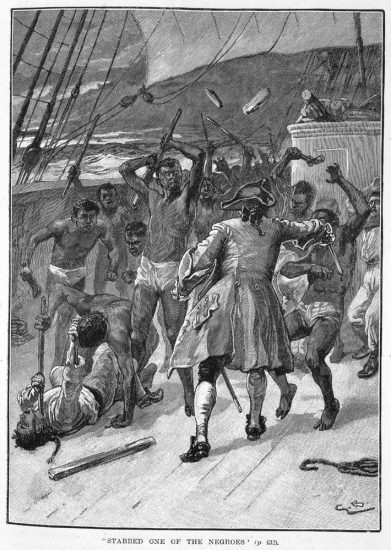
The Creole was a slave ship owned by the Johnson-Eperson Co. that set sail in November 1841 carrying 135 enslaved Afrikans & shipments of tobacco from Richmond, VA to New Orleans, LA. Among them was a brotha given the name, Madison Washington - a runaway slave from Canada who was captured in VA while searching for his wife - and his wife, given the name, Susan.
On Nov 7th, Washington along with 18 other males made their move to overthrow the ship. They overpowered the crew, killing one of the slavers in the process. The ship’s wounded captain, family, & crew survived the battle. The battle was a success though not without its cost; one of the rebels was mortally wounded and succumbed to his injury. Desperate to save his own neck, the overseer on board swore he'd navigate the ship for them.
First, the rebels demanded they set sail for Liberia, Afrika; but the long distance and low food/water supplies ixneyed that possibility. One of the rebels, a brotha given the name, Ben Blacksmen, asserted that they should aim for the British controlled islands in the West Indies; word had spread of previous rebels gaining their freedom there after overtaking American slave ships. He hoped the same fortune would befall them.

They arrived in Nassau, Bahamas 2 days later. There, they were met by the harbor pilot and his men - a crew of all local Black Bahamians. The harbor pilot declared them free once ashore. Upon discovering that the Creole's captain was also mortally wounded, the American consul was notified of the revolt and demanded the arrest of Washington & all 18 rebels implicated in his death under charges of Mutany. His wife, Susan, and the other Afrikan survivors were given leave to live freely within the British boundary of the West Indies.
Some stayed in the Bahamas to start a new life, others sailed for Jamaica to do the same. Only 5 survivors chose to remain aboard the Creole set sail for New Orleans, LA to return to American Slavery ; 3 women, 1 boy, and 1 girl. It wasn't until April 16th of the next year that Washington and the other 18 rebels were freed and joined their companions on West Indian soil as freefolk.
Moreover, for their courage, unity, & nerve, 128 enslaved Afrikan Peoples gained their freedom from this day, making the Creole Slave Revolt THE most successful revolt in U.S. history.
We pour libations of water, speak their names, & offer prayers toward their elevation - especially those lost & returned to bondage.
#hoodoo#hoodoos#the hoodoo calendar#The Creole#The Creole Slave Revolt#Slave rebellion#Slave revolt#Freedom Fighters#black history
194 notes
·
View notes
Text
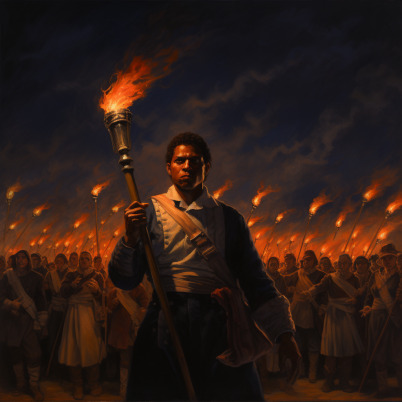
Gabriel Prosser: Igniting Freedom and Defiance Against Slavery
#black power#black excellence#slave rebellion#richmond#richmond virginia#Gabriel Prosser#tik tok#black tik tok
27 notes
·
View notes
Text
The Problems with Slavery:
0 notes
Text
1 note
·
View note
Text
Denmark Vesey (aka Telemaque), a Black American carpenter, is accused of planning a slave rebellion in Charleston, South Carolina. He would be tried & convicted, & 35 enslaved people would be executed by hanging. June 16, 1822.
Subscriber Content Add content here that will only be visible to your subscribers. Payment Image: Denmark Vesey (Public Domain) On this day in history, June 16, 1822, Denmark Vesey (aka Telemaque), a Black American carpenter, is accused of planning a slave rebellion in Charleston, South Carolina, involving thousands of enslaved Black people and the subsequent murder of antebellum slave…

View On WordPress
1 note
·
View note
Text

William Styron: The Confessions of Nat Turner (1967)
#william styron#nat turner#american history#enslaved#slave rebellion#time 100#pulitzer prize#us history#virginia#southampton
1 note
·
View note
Text
REBELLION RISING ON THE RISE: 2009-2018
THE FRANCE AND IRISH LINK TO THE REBELLION:
THE PARANORMAL HOTSPOT IN ROUSE HILL REGIONAL PARK
THE REAL CENTER OF THE CIVIL WAR OF THE REBELLION OF VINEGAR HILL PART 1:

My hypothesis is there is a link to the slave revolts in Haiti and the Battle of Vinegar ill where the Irish slaves attempted to overthrow their English captors.
This is founded by my initiation into haitian voodoo, 21 divisions creole spiritism which combines with my cereominal magician tradition starting HARDCORE at the same site (the battle site of vinegar hill) back in 2009.
All events were extreme paranormal and unexplained anomalous events, experienced by a friend and I who were yet to be formally initiated into ceremonial magick or vodou.
A magical portal was opened which took me until 2018 to close
many ufo and other supernatural events took place at this site
which can be ascribed to the closest site to the only civil war in Australia has ever witnessed.

My notes on the historical context from 2022
1789
After 1789, some Volunteer units showed their sympathy with the French Revolution by holding parades on 14 July to commemorate the fall of the Bastille. In 1792, Grattan succeeded in carrying an Act conferring the franchise on the Roman Catholics; in 1794, he introduced a reform bill that was even less democratic than Flood’s bill of 1783.
He was as anxious as Flood had been to retain the legislative power in the hands of men of property, for he had a strong conviction that while Ireland could best be governed by Irish hands, democracy in Ireland would inevitably turn to plunder and anarchy. The defeat of Grattan’s mild proposals helped to promote more extreme opinions. However, as soon as the Jacobin regime assumed power in France, radical Patriots became more reluctant to refer to France as a prime example of Catholic political action for the causes of liberty and justice. Nevertheless, one of the main inconsistencies on the Patriot political agenda by calling for increasing powers of the Irish parliament while maintaining the selective as opposed to universal suffrage seemed to have been dissolved.
However, the French Revolution also had a second, contrasting, effect. Conservative loyalists such as John Foster, John Fitzgibbon and John Beresford, however, remained opposed to further concessions to Catholics and, led by the ‘Junta’, argued that the ‘Protestant Interest’ could only be secured by maintaining the connection with Britain. In reactionary circles, it was used to emphasise the point that an open political debate without censorship as well as parliamentary reform could entail a severe blow to their special interests, and could be tantamount to inviting Radicals to overturn the political structure of the country, rather than just appeasing them. In particular, the French Revolution prompted relentless action against the radical wing of the Patriot movement, the United Irishmen that included many former Whigs. It also prevented more moderate Patriots from supporting some radical Patriot activities without reservation, depriving the Patriot movement of solidarity and unity.
1688-91
WILLIAMITE WAR
William of Orange - dutch born
William of Orange, the Dutch prince who became King of England, Scotland, and Ireland in the Glorious Revolution of 1688
Defeated catholic "james 2nd" in wiliamite-jacobite war.
Protestant ascendancy
THE DECLATORY ACT OF 1719
Loss of Independence due to the House of British Lords being able to pass laws in Ireland
Restrictions of commerce at the expense of ireland that favoured Britain were tipping this rise to the protestant ascendancy for GREATER freedoms from great britain.
ORANGE ORDER:
The basis of the modern Orange Order is the promotion and propagation of "biblical Protestantism" and the principles of the Reformation. As such the Order only accepts those who confess a belief in a Protestant religion.
As well as Catholics, non-creedal and non-Trinitarian Christians are also banned.
This includes members of The Church of Jesus Christ of Latter-day Saints(Mormons), Jehovah's Witnesses, Unitarians, and some branches of Quakers.
Previous rules specifically forbade Roman Catholics and their close relatives from joining
but the current rules use the wording "non-reformed faith" instead. Converts to Protestantism can join by appealing to Grand Lodge.
James Wilson and James Sloan, who issued the warrants for the first Lodges of the Orange Order along with 'Diamond' Dan Winter, were Freemasons,[26] and in the 19th century many Irish Republicans regarded the Orange Order as a front groupestablished by Unionist Masons as a more violent and jingoist vehicle for the promotion of Unionism.[71] Some anti-Masonic evangelical Christian groups have claimed that the Orange Order is still influenced by freemasonry.[72] Many Masonic traditions survive, such as the organisation of the Order into lodges. The Order has a similar system of degrees through which new members advance. These degrees are interactive plays with references to the Bible. There is particular concern over the ritualism of higher degrees such as the Royal Arch Purple and the Royal Black Institutions
1795: the battle of richmond hill
Darug natives defend the land from british invaders
North richmond - pitt town wetlands.
1798
The first battle of vinegar hill
County wicklow
The catholics invasion and claim to the irish land and protestant ascendancy
Act of union 1800- rise to catholic invasion that allowed the mobilisation of the catholic poplation
Uniteed the british parliament and irish parliement in unity, to form a united front
Catholic resentment in leinster
1789
THE AFRO-CARIBBEAN LINK
UNITED IRISH PRISONER
JAMAICA
WEST INDIES
NEW FOUNDLAND
NEW SOUTH WALES
"United Irish" mutinies in Jamaica, Newfoundland and New South Wales
In October 1799 Castlereagh received reports from Jamaica that many (of the 3,200)
United Irish prisoners, "incautiously drafted" into regiments for service in the West Indies, had taken to the hills to fight alongside the Maroons and with the French: "as soon as they got arms into their hands they deserted".
There is no suggestion that this was part of any trans-Atlantic design of the United directory in Dublin or Paris.
The same is true of the "United Irish Uprising in Newfoundland" in April 1800. Two-thirds of the colony's main settlement, St. John's, were Irish, as were most of the island's locally-recruited British garrison. There were reports that upwards of 400 men had taken a United Irish oath, and that eighty were resolved to kill their officers and seize their Protestant governors at Sunday service. As in Jamaica, the mutiny (for which 8 were hanged) may have been less a United Irish plot, than an act of desperation in the face of brutal living conditions and officer tyranny.
Yet the Newfoundland Irish would have been aware of the agitation in the homeland for civil equality and political rights.
There were reports of communication with United men in Ireland from before '98 rebellion;of Thomas Paine's pamphlets circulating in St John's;and, despite the war with France, of hundreds of young Waterford men still making a seasonal migration to the island fisheries, among them defeated rebels who are said to have "added fuel to the fire" of local grievance.
In March 1804, stirred by news of Emmet's rising, several hundred United Irish convicts in New South Wales tried to seize control of the penal colony and to capture ships for a return to Ireland.[204] Poorly armed, and with their leader Philip Cunningham seized under a flag of truce,the main body of insurgents were routed in an encounter loyalists celebrated as the Second Battle of Vinegar Hill.
The 1803 Michael Dwyer, who was a captain of the irish rebellion of 1798, transported to NEW SOUTH WALES
-1807 x 2 imprisoned and x2 trials for plotting against the british penal rule in NSW
1804
The second battle of vinegar hill
LIBERTY OR DEATH!
‘Death or Liberty’
The 1804 Castle Hill convict rebellion was led by Philip Cunningham of Moyvane, north County Kerry, a government stonemason who was convicted for his involvement in the 1798 Irish rebellion; he was also involved in a mutiny on board the convict transport ship, the Anne.
He was key figure in the planning of the rebellion, along with his rebel assistants William Johnston and Samuel Humes.[
Accompanied by over 200 frustrated armed Irish convicts, their aim was to capture ships and sail to Ireland. The rebels gathered at Castle Hill, calling on other convicts to join them.
Their intention was to march from Windsor to Parramatta, and then onto Sydney, gathering recruits along the way to attain a ship to bring them back to Ireland.
The Irish rebels were betrayed by an informer Keogh, who told the authorities of the Irish convicts’ plans.
By 1804, most of the Irish leaders of the previous attempts at rebellion had been imprisoned and moved to outlying areas of the colony such as Norfolk Island. Dispersal had worked well for the authorities but with each new rebellion plan, new Irish leaders rose among the convicts more aware of what not to do next time. The leaders of rebellion on 4 March 1804 were Phillip Cunningham and William Johnston.
Cunningham was a veteran of the 1798 conflict in Ireland and the mutiny of the convict transport ship Anne. From his experiences in Ireland and NSW he understood that secrecy and a non-traceable but effective communication were essential to a successful rebellion.
Cunningham’s emphasis on secrecy was so successful that it was not until the day before the rebellion that the authorities knew of its existence.
On the evening of 3 March, one of the Irish convict overseers turned informant. On Sunday 4 March, the day of the rebellion, two more informants came forward and provided names.
John Griffen was one of the informants and had been relaying a message to the pike-maker Bryan Furey that the rebellion was on for Sunday night.
Since Furey did not get the message the areas of Sydney, Parramatta and Windsor did not rebel.
Castle Hill was the only district that rose in rebellion.
Despite this intelligence, the authorities in Parramatta and Sydney did not act immediately and on 4 March 1804, John Cavenah set fire to his hut in Castle Hill at 8.00 pm. This was the signal for the rebellion to begin.
With Cunningham leading, 200 rebels broke into the Government Farm’s buildings, taking firearms, ammunition and other weapons. Initially, there was mayhem as buildings were ransacked to cries of ‘Death or Liberty’. Two English convicts dragged the Hills District flogger, Robert Duggan from under his bed and George Harrington an English convict beat him unconscious. A constable was saved from a musket ball in the face when the musket of John Brannon misfired.
Another constable was saved in similar circumstances when Jonathon Place’s musket also misfired. Cunningham gathered the rebels and reprimanded them for their lack of disciplined behaviour.
The rebels then went from farm to farm on their way to Constitution Hill at Parramatta gathering firearms, supplies and drinking any liquor they found. The looting of farms gave the rebels over 180 swords, muskets and pistols. In 1804, this was close to one third of the colony’s entire armoury
I do therefore proclaim the Districts of Parramatta, Castle Hill, Toongabbie, Prospect, Seven and Baulkham Hills, Hawkesbury and Nepean to be in a STATE of REBELLION; and to establish Martial Law throughout those Districts…
Cunningham’s plan involved burning the MacArthur property of ‘Elizabeth Farm’ in order to draw the Parramatta garrison out of the town.
Once this was done the rebels in Parramatta would rise up and set fire to the town as a signal. The Castle Hill rebels would gather at Constitution Hill and then raid the barracks for more arms and ammunition.
From there the rebels would march to Windsor and join up with the rebels in the Hawkesbury before marching on Sydney. At dawn on 5 March, rebels were still straggling in to Constitution Hill. Phillip Cunningham and William Johnston were busy drilling the rebels on the hill while they were waiting for the signal from the uprising rebels in Parramatta. The signal never came. Cunningham’s messages to the Parramatta and Windsor rebels had not got through. Cunningham decided that the rebels would head down the Hawkesbury Road to Windsor to meet up with the rebels from the Hawkesbury. Had Cunningham effected this, King maintained it would have increased his force by a further hundred rebels.[10]
Colonial paranoia increased once evidence of planned rebellion became evident after 1800 but how real was the threat from Irish convicts?
The Defenders and United Irishmen transported between 1795 and 1806 provided leadership to those convicts, many Irish but including English transportees, who were prepared to take direct action to overthrow the colonial authorities.
Although it was the Irish convicts who were a particular concern to Hunter, King and Bligh, it is important not to over-exaggerate their significance while under-estimating the involvement of convicts of other nationalities. In addition, the Irish convict leadership had considerable experience in planning and implementing rebellious activities.
This explains why successive governors sent leaders or presumed leaders, whether there was concrete evidence of sedition or not, to the more isolated penal settlements on Norfolk Island and VDL. This had the effect of disrupting any planning for insurrection.
Finally, hatred of the British in Ireland was transposed to NSW and this meant that Irish leaders had a willing supply of convicts who were prepared to support their actions.
That support came from non-Irish convicts is a reflection of the punitive and arbitrary nature of convict life. Where they were concentrated in one area, as on the Castle Hill farm, Ireland’s cause helped bind these men together.
However, there were major problems for those seeking rebellion. First, keeping planning secret was a major difficulty and only the Castle Hill revolt in 1804 saw planning converted into action.
Convicts were always willing to ‘split upon each other’ and this allowed the authorities to intervene before matters spiralled out of control.
Secondly, the objectives of rebellion such as the rallying cry of ‘Death or Liberty’ or demands for a ship to go home were idealistic and unrealistic. Although these may have been the aims of rebel leaders, there is little evidence that they were widely held by the rank-and-file, many of whom claimed that they had been forced into rebellion
Thirdly, as in Ireland during the 1798 rebellion, when faced with even inferior military force, the rebels could not translate numerical strength into military victory.
Finally, the hoped for French aid was illusory as it was never part of French strategy and, during the critical period from 1801 to 1804 war in Europe had been suspended.
It was the British government that was constantly afraid of convict rebellion and disorder though this did not stop it from sending political prisoners to NSW despite the concerns of successive governors. For the authorities, a colony composed largely of convicts was inevitably turbulent and rebellious, something reflected in Hunter’s and King’s despatches. In his reports on NSW and VDL, Bigge considered that the best security against rebellion was the higher standard of living that convicts generally enjoyed in NSW than in Britain and the opportunities and rewards open to those with industry and skill. Some convicts ‘bolted’ but only a few rebelled.
Rouse Hill Estate
Vinegar Hill was not a formal location in 1804.
The battle between the rebels and the soldiers became commonly known as the ‘Battle of Vinegar Hill’ after the Irish battle in 1798. Common usage of the name Vinegar Hill began to appear in the 1810s and 1830s in the Rouse Hill area.
But there is no formal Vinegar Hill on a map. There have been competing thoughts for the location of Vinegar Hill.
Originally it was thought to be Rouse Hill, George Mackanass challenged this in the 1950s marking the location of Vinegar Hill as the crossroads between Windsor Road and Schofields Road.
THIS WAS THE LOCATION OF ROUSE HILL REGIONAL PARK, in which my friend and I partook in rituals with an optical crystal ball resulting in FULL BLOWN MANIFESTATIONS.
-1816
Richard rouse
Built tollhouses, turnpikes, estates from Parramatta to Liverpool
On 8 October 1816 Rouse was granted 180 hectares (450 acres) near the site of the Castle Hill convict rebellion; at the suggestion of Macquarie the grant was named Rouse Hill. The actual possession of the land had taken place a few years previously, as the Sydney Gazette had first mentioned Rouse Hill on 27 November 1813, and the homestead was begun soon afterwards. It took a few years to build and was a two-storey, twenty-two room house, which has been occupied by members of the Rouse family ever since.
Old government house & THOMAS MITCHELL ROYAL PEDIGREE ANCESTRAL ASSET
& THE HIDDEN HAND OF PARRAMATTA GOVERNMENT HOUSE AND THE TIMEKEEPERS SOUTHERN HEMISPHERE
this is an actual freemasonic ancestral connection of mine... this links to the rebellion and the colonisation of the country.
The Observatory, erected in 1822 was part of Brisbane's intention to make Parramatta "the Greenwich of the Southern Hemisphere" (DPWS 1997: p. 39).
1828, when Thomas Mitchell began the first trigonometrical survey of New South Wales, his initial meridian was taken from the Parramatta transit instrument in consultation with Dunlop. That survey underpinned mapping in New South Wales until recent times (Rosen 2003: p. 80).
Surveyor Edward Ebbsworth, when conducting his 1887 survey of Parramatta Park, ensured that the exact location of the piers would be preserved by fixing a copper plug in the basal stone of the piers.
Brisbane was accompanied to Australia by two astronomers: Charles Rumker, who had already attained a good reputation as an astronomer and mathematician; and James Dunlop, whose great natural ability in mechanical appliances and instruments saw him identified as a suitable man for second assistant in the Observatory in an out of the way place like Parramatta. On arrival in New South Wales, Brisbane's instruments were immediately set up on piers in the Domain to allow the observation of the solstice on 21 December 1821. B
April 1822, the construction of the observatory had been completed in anticipation of the appearance of Encke's Comet, an event not observable in Europe or at the Cape of Good Hope (Rosen 2003: p. 80).
The observatory was privately funded by Brisbane and consisted of two buildings: an observatory equipped at Brisbane's personal expense; and a residence attached to it. Located about 91 m (100 yards) behind Government House, the observatory was a plain building, 8.5 m (28 feet) square by 3.4 m (11 feet) high, with a flat roof with two domes 3.51 m (11 feet 6 inches) in diameter projecting from it, one at the north and the other at the south.
On the north and south sides were five windows, three of which were in a semi-circular projection from the wall at the base of the domes.
Transit openings in the domes extended to one of the windows to allow observations of the horizon. A 0.41-metre (16 in) Reichenbach repeating circle was located under the north dome and a 1.2-metre (46 in) equatorial Banks telescope was under the south dome.
There was also a Troughton mural circle and a 1.7-metre (5+1⁄2 ft) Troughton transit instrument. A Hardy clock showed sidereal time and a Brequet clock showed mean time.
All instruments were mounted on solid masonry piers.
There was also a Fortin pendulum and two instruments for observing the dip and variation of the magnetic needle.
CONVICT LIES
O’Farrell estimates about 1.5% of these were unambiguously sent out as political offenders or participants in rebellion or conspiracy, with the great bulk of these coming in the aftermath of the 1798 Rebellion.
If crimes of agrarian discontent and social disaffection are included under the heading of ‘political crimes’, then the proportion of Irish political transportees rises to about 20%. The great majority of Irish convicts were, therefore, sent to Australia largely for petty crimes.
Theory to link back to
JOHN DEE AND THE OPTICS OF THE CRYSTAL BALL USED BY THE MONARCHY OF BRITISH CROWN
BASED ON THE PROJECTION INTO THE ASTROLOGICAL, ASTRONOMICAL TRANSITS TO CONQUER VIA USING EDWARD KELLY AS "COURT MAGE" AND THE ENOCHIAN CHESS IN THE GLOBAL CONQUEST
real scrying methods take two or more people in the spiritual court for impact, as per 2009 - 2014 when K and I had adopted the original crystal ball between us resulting in full-blown manifestations, later confirmed by Kardec spiritism sources
my spirits advise me Australia is the prime spot for HAITI 2.0 FOR THE SECOND COMING OF THE SLAVE REVOLT IF THINGS CONTINUE THIS WAY ....
note the date and time and motions of movement
note the present economic, social and political happenstance
note the pestilence that has persistence against the masses who only want freedom and peace
note the objections from the overlords through clauses like agenda 2030, and sustainable development, which are just fancy names for the "new world order". which is just a modern 'human slave agenda" decked out in bureaucratic red tape.
freedom of choice, or be denied all liberty?
look at the manipulation that occurred as a result of COVID-19 and the forced COVID-19 vaccine agenda
when will the next thing that replicates occur, and when will humanity rise against the overlords to object in the most amicable and peaceful or diplomatic way, as clearly, the violence and bloodshed aren't going to work here.
PEACEFUL REBELLION.


#john dee#crystal ball#vinegar hill#1804#rebellion#the battle of vinegar hill#australian history#haunted australia#paranormal australia#parramatta#john dee and edward kelley#thomas mitchell#rouse hill regional park#supernatural australia#haunted places in australia#ley lines#the rum rebellion#haitian revolt#slave rebellion#irish rebellion#liberty or death#calling down the lwa.#rum rebellion#crystal balls#scrying#spiritism#haitian vodou#ogun#spirts#revolt
1 note
·
View note